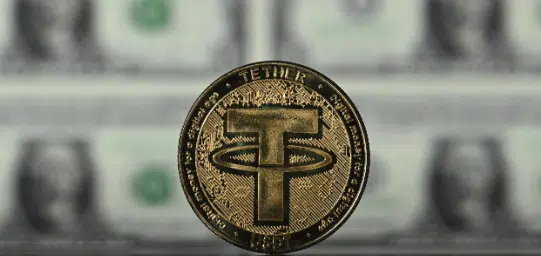TLDR
This article dives into the captivating world of stablecoins – a digital currency that offers peace of mind in a volatile market. Let us start by ranking the best stablecoins in the cryptocurrency market.
- Tether (USDT)
- USD Coin (USDC)
- Binance USD (BUSD)
- Dai (DAI)
- True USD (TUSD)
- Paxos Standard (PAX)
We will then explore stablecoins’ types and where they derive their value. Then, we will review both sides of the stablecoin – advantages and disadvantages – giving you insights that will help you decide whether investing in these coins is right for you.
Get ready to uncover the intricacies of stablecoins and gain a deeper understanding of this game-changing asset.
The Best Stablecoins Right Now
Are you curious about top stablecoins and their potential impact on cryptocurrency? As we look toward this year, it’s clear that not all stablecoins are created equal. To give you a head start, we’ve compiled a must-know list of the top 6 stablecoins on the market today.
Keep reading to discover which top stablecoins are making waves and could yield exceptional results.
1. Tether
Are you seeking a stable cryptocurrency option in the increasingly unpredictable digital currency?
Look no further than Tether (USDT). Unlike other cryptocurrencies, Tether is pegged to the U.S. dollar, meaning that its value is always set at $1. This makes it an excellent choice for those who want to avoid the high volatility of other digital currencies.
But how does Tether achieve this stability?

By linking its value to a real-world asset: the U.S. dollar. Tether Holdings achieves this by maintaining a reserve system, holding an equivalent amount of U.S. dollars for every Tether token in circulation. So if you’re looking for a reliable cryptocurrency option, Tether is worth considering.
2. USD Coin
The cryptocurrency world has a new star – USD Coin (USDC). This stablecoin is like no other, offering a reliable and secure form of payment in the unpredictable digital currency world. Launched in 2017, USDC has quickly gained popularity thanks to its peg to the U.S. dollar.

This innovative digital currency is worth exploring for those who prefer stable investments. Additionally, USDC’s availability on the Ethereum Blockchain makes it open and accessible to anyone with an Ethereum wallet. In a world where trust is everything, USDC is emerging as a trustworthy and dependable option for those seeking a more stable digital currency. Read our guide on how to stake USDC here!
3. Binance USD (BUSD)
Binance USD is a top-tier stablecoin that is always worth one U.S. dollar. Owing to its 1:1 ratio, BUSD garners the trust of investors, traders, and merchants alike. Paxos, the issuer of Binance USD, is a reputable financial institution that guarantees each BUSD token is backed by a U.S. dollar held in reserve.

With full regulatory approval and compliance with the New York State Department of Financial Services (NYDFS), BUSD offers traders and investors peace of mind when conducting transactions. Additionally, it is extremely versatile, serving various purposes beyond trading and investing, such as payment for products or services.
Its extensive availability on platforms like Binance allows users to access a range of cryptocurrencies they can buy using their digital currency.
4. DAI
Meet Dai, the revolutionary stablecoin birthed by MakerDAO, a decentralized autonomous organization (DAO) founded by Rune Christensen in 2014. By creating a decentralized stablecoin, MakerDAO aims to give everyone an equal chance to participate in the global economy, regardless of location or financial status.
And the key to this vision? Dai is a cryptocurrency fully backed by collateral in the form of other cryptocurrencies, ensuring its value stays stable. With Dai, the possibilities for accessible and equitable finance are endless.

Dai, backed by cryptocurrencies rather than fiat currency, ushers in a new era of stablecoins. Its intrinsic value doesn’t depend on the fluctuations of a single currency; instead, it derives from the value of its diverse and robust collateral. This innovative approach makes Dai a stablecoin worth keeping an eye on.
5. True USD (TUSD)
In the world of stablecoins, TrueUSD stands out as a unique offering from the fintech company TrustToken. With other stablecoins in their portfolio, such as TrueGBP and TrueAUD, TrustToken has established itself as a leader in tokenized assets. However, TrueUSD’s collateralization model sets it apart from the competition. Fully backed by U.S. dollars held in escrow accounts, TrueUSD offers stability that other stablecoins can only dream of.

TrueUSD guarantees every TUSD token in circulation with a matching U.S. dollar held in reserve, verified daily by independent accountants for full transparency and accountability. Plus, built on the Ethereum Blockchain, TrueUSD transactions are lightning-fast and incredibly cost-effective.
6. Paxos Standard (PAX)
Paxos Standard emerged to achieve parity with the American dollar, addressing the controversy surrounding Tether’s inconsistent printing habits. Tether faced criticism for claiming a staggering $1.8 billion in their dollar reserves without adequate documentation from Deltec Bank & Trust.

Trusted Partners
What Are Stablecoins?
Stablecoins are cryptocurrencies that maintain a relatively stable price, unlike other crypto assets whose prices can be highly volatile. Their low-cost and efficient transactions offer an attractive alternative to traditional fiat currencies.
Stablecoins are backed by various assets like fiat currencies or commodities, which makes them more stable than other cryptocurrencies.
With their stability and low transaction fees, stablecoins offer a wide range of advantages for users looking for a reliable way to store and transfer value.

Types of Stablecoins
In the vast world of cryptocurrency, stablecoins come in many shapes and sizes. These digital coins are unique and distinguished by the underlying asset that supports them.
Let’s look at the most common types.
U.S. Backed Stablecoins
Stablecoins with USD backing, such as Tether (USDT), offer a secure and dependable investment option in cryptocurrency. With a 1:1 peg to the U.S. dollar and tangible reserve backup, Tether provides stability and peace of mind for investors seeking a less volatile alternative.
Commodity Backed Stablecoins
Commodity-backed stablecoins are popular stablecoins stabilized by hard assets like gold or real estate. Gold is often the go-to asset for backing these coins, but many stablecoins use a mixture of precious metals and crypto assets to diversify their portfolios.
By holding assets with real-world value, commodity-backed stablecoins seek to minimize price fluctuations and provide users with a more stable and secure investment option.
Fiat-Backed Stablecoins
Fiat-backed stablecoins are becoming more popular in cryptocurrency as they provide security and stability. While the U.S. dollar price pegged and secured most stablecoins, other stablecoins are pegged and guaranteed by other fiat currencies like the Chinese yuan.
Precious metals like platinum and silver back some national currencies. To establish legitimacy, an independent custodian is appointed to manage the currency reserve and is audited regularly to ensure adherence to regulations.

Crypto-Backed Stablecoin
Some coins can even be collateral for other coins in the cryptocurrency world. Enter crypto-backed stablecoins, designed to counteract the relative instability of crypto-backed coins. They often hold an overcollateralized position to ensure stablecoins maintain their intended value (usually $1).
This indicates that they are ready to withstand significant fluctuations in the market cap of cryptocurrencies, supporting them while maintaining a secure and stable investment.
Stablecoins operate on a different currency circulation system than traditional fiat currencies. Instead of having a 1-to-1 currency ratio to reserves, a crypto-backed stablecoin may issue only a small portion of its total value in coins against reserves.
This means stablecoins are pegged and can be backed by a much smaller percentage of actual money in reserve. This makes them an innovative and potentially more efficient currency form in the crypto world.
What Are Algorithmic Stablecoins?
Stablecoins are like the Swiss Army knives of the crypto world – specifically designed to maintain a stable value relative to a trusted currency like the U.S. Dollar. These nifty little digital currencies are a favorite among cautious investors who want to stay in the cryptocurrency game without risking sharp market price fluctuations.
But algorithmic stablecoins are different! They may seem magic at first glance, as they don’t rely on any external asset to stabilize their value. Instead, they use highly specialized algorithms that dictate market participant behavior and manipulate circulating supply to keep prices within the desired range.
Best Algorithmic Stablecoins
Do you seek a stablecoin that operates on algorithms rather than fiat currency? There are plenty of other options worth considering. Here are some top algorithmic stablecoins that could fit the bill.
1. Frax
Introducing Frax, an innovative algorithmic stablecoin that is quickly becoming one of the most popular options in decentralized finance. Founded By Sam Kazemian, this cutting-edge protocol is designed to offer a decentralized, scalable, and highly algorithmic stablecoin that is open-source and permissionless on Ethereum’s blockchain.
Frax, emphasizing decentralization, aims to transform the DeFi money market and facilitate a new era of innovative finance. So, if you’re looking for a stablecoin that offers unbeatable scalability, security, and transparency, Frax is a perfect choice.
2. Ampleforth
Ampleforth, an Ethereum-based cryptocurrency, is another addition to the best algorithmic stablecoins. Its unique model stands out as a form of regulation by adjusting its circulating supply with algorithms. This creates a viable asset that can remain free from dilution even if there is inflation in supply and not succumb to price volatility like other cryptocurrencies – making it perfect for serving as base money championing decentralization within modern economies.
Ampleforth is a unique decentralized stablecoin using a flexible supply to maintain price stability. Compared to other algorithmic stablecoins, it stands out in the rebasing stablecoins category. Ampleforth achieves better price stability by adjusting its supply through a rebasing mechanism than fixed-supply cryptocurrencies. Moreover, its stablecoin AMPL is both non-dilutive and elastic, making it a reliable choice for investors.

3. Magic Internet Money (MIM)
Magic Internet Money is the go-to platform for those looking for a top-notch algorithmic stablecoin. You can easily find it on major crypto exchanges, including Curve Finance, Uniswap, and PancakeSwap.
Here’s how it works: Deposit interest-bearing assets and use them as collateral for borrowing the stablecoin. With Magic Internet Money, you can trust that your crypto is secure and dependable.
What is Behind Each Stablecoin
Here is a look at the team behind each of the stablecoins mentioned above:
Who is behind USDC?
The USD Coin, a virtual currency making waves in the digital world, owes its creation to the Centre consortium. This conglomerate of top-tier companies, led by Circle, a fintech powerhouse from Boston, Massachusetts, joined forces with crypto titan Coinbase and Bitcoin aficionados Bitmain to birth an innovative payment system for the modern era.
Indeed, USDC is the currency that powers Circle’s global payment service, and it’s a currency with many sways. Circle is valued at an impressive $9 billion, underscoring the potential and promise of this burgeoning financial ecosystem.
Who is behind BUSD?
Binance, a top-tier cryptocurrency exchange, created BUSD, a stablecoin backed by U.S. dollars and regulated by the Paxos Trust Company. This cutting-edge technology ensures that every BUSD is fully backed by a reserve of dollars held in a secure account, similar to the USD Coin.
Plus, both Binance and Paxos bring a wealth of industry-leading expertise. The BUSD system fully complies with New York State financial regulations, allowing for a seamless and trustworthy experience.

Who is behind DAI?
Rune Christensen founded Dai, the Maker Foundation’s first stablecoin, in 2014 as an Ethereum-based cryptocurrency. The decentralized autonomous organization (DAO) comprises MKR governance token holders, who contribute significantly to the cryptocurrency’s future direction and parameters. Dai stands out in the cryptocurrency world, as it is not linked to traditional assets like U.S. dollars or gold, unlike other stablecoins.
The value of Dai is closely tied to market demand – when the price goes up, more people flock to create it. Conversely, people are likelier to return their assets to the pool when prices drop. Unfortunately, Dai suffered instability due to Ethereum’s wild price swings in 2020.
However, MakerDAO has since wisely diverted much of its holdings to USD Coin – one of the market’s most popular and the first stablecoins. Each Dai token is backed by a balanced mix of 62% USDC and 29% ETH. Despite experiencing some challenges, Dai remains a prime example of smart contract technology.
Who is behind TUSD?
True USD is the first stablecoin back that has gained traction since its launch in 2018. Operated by the TrustToken team, this coin is backed by the U.S. dollar with a 1:1 ratio. TrustToken is a promising platform with collateral for various asset-backed tokens, including True USD.
Despite being a young project, TrustToken can boast some impressive technology names in the field. However, the team has somewhat limited financial experience.
The company is based in San Francisco, California, a hub of innovation and development in the tech industry. With these exciting elements in play, True USD is certainly a stablecoin to watch.

What is backing USDD?
Justin Sun, a prominent figure in the world of cryptocurrency and the founder of Tron blockchain, has introduced a new stablecoin called USDD.
The stablecoin, pegged to the U.S. dollar, launched on BNB Chain, Ethereum, and TRON, and a decentralized autonomous organization (DAO) on the TRON blockchain manages it.
Unlike other stablecoins backed by real-world assets, USDD is over-collateralized with a diversified crypto-asset basket, including TRX, BTC, and USDC. As a result, this stablecoin helps maintain a 1:1 peg with the USD and offers a decentralized alternative to traditional fiat currencies.
Advantages and Disadvantages of Investing in Stablecoins
The financial world has witnessed a rise in the use of stablecoins, attracting individuals and businesses who need to transact internationally. To understand their significance, we have outlined the top advantages of stablecoins.
Advantages of Stablecoins

Zero Volatility
Given their peg to a fiat currency or commodity, stablecoins are a dependable form of cryptocurrency that typically avoids rapid fluctuations, rendering them more viable for utilization on a broader scale. Additionally, with the integration of blockchain technology, they provide a profitable and secure means of conducting transactions. Hence, stablecoin’s adoption is set to rise in the coming years.
Hedge Against Failing Markets
Stablecoins innovative coins are rapidly gaining popularity among traders who want to protect themselves against price drops in other cryptocurrencies. Traders can quickly turn their digital assets into cash and jump back into the market just as easily when prices stabilize. It’s a smart way to stay on top of the volatile crypto market and minimize risk.
Disadvantages of Stablecoins

Transparency
The opaque nature of several stablecoins has been under scrutiny in recent times. Among them, Tether has gathered a lot of negative attention for not being adequately transparent with its reserves, which has resulted in strict regulations and penalties from the U.S. government. Tether has finally shared a report detailing their current reserve holdings to regain public trust.
Centralization
Although blockchain and cryptocurrencies promote decentralization, stablecoins introduce a level of centralization, especially regarding asset backing. An overseeing centralized team is required to ensure equal reserve value for every circulating coin. This can appear both necessary and concerning for those invested in the concept of decentralization.
Summary
In conclusion, the rise of stablecoins presents an exciting opportunity for investors to diversify their digital asset portfolio. As their mechanism becomes better understood and more widely adopted, they continue to gain traction in the marketplace as a reliable and versatile medium of financial exchange.
Though there are pros and cons of investing in stablecoins, proper assessment of key factors can provide a sound foundation for prospective users to make an informed decision. With this newfound knowledge of how these cutting-edge tokens work, savvy investors should research the upcoming major players in the stablecoin industry.
Understanding what differentiates them from traditional cryptocurrencies is critical for successful investment decisions.
In 2023, the top 5 stablecoins may change due to market fluctuations, but currently, the most popular options are Tether (USDT), USD Coin (USDC), Binance USD (BUSD), Dai (DAI), and TrueUSD (TUSD).
Stablecoins are cryptocurrencies that purportedly have fiat currencies backing them. Unlike cryptocurrencies such as Bitcoin, their prices remain constant.
According to analysts, Tether's stability made it the safest bet among stablecoins during the U.S. banking crisis.













